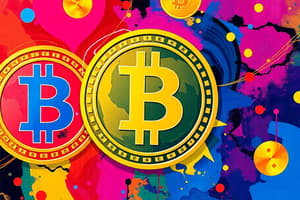Podcast
Questions and Answers
Given a cryptocurrency project intending to implement a deflationary model, which of the following scenarios would MOST effectively achieve sustained price appreciation through controlled scarcity, while simultaneously incentivizing long-term holder commitment and mitigating risks associated with market manipulation?
Given a cryptocurrency project intending to implement a deflationary model, which of the following scenarios would MOST effectively achieve sustained price appreciation through controlled scarcity, while simultaneously incentivizing long-term holder commitment and mitigating risks associated with market manipulation?
- Introduce a dynamic burn mechanism that adjusts the burn rate based on network activity and trading volume, complemented by a quadratic vesting schedule for early investors over 5 years, and a strict maximum supply cap algorithmically reduced based on predefined milestones achieved by the project. (correct)
- Apply a one-time token burn event of 50% of the total supply, followed by an inflationary staking reward system to incentivize holding, with team tokens unlocked immediately to foster transparency, and no maximum supply to allow for adaptive monetary policy changes.
- Establish a lottery system where a portion of transaction fees are used to buy back and burn tokens randomly, combined with a vesting cliff of 1 year for all stakeholders, and a perpetually increasing supply controlled by a DAO vote every quarter to adapt to market conditions.
- Implement a fixed percentage burn rate on all transaction fees, coupled with a linear vesting schedule for team tokens over a 2-year period, and a maximum supply cap set far beyond current market demand, ensuring scarcity is only realized in the distant future.
In the context of decentralized governance, how does the synergistic integration of governance tokens with a Delegated Proof of Stake (DPoS) consensus mechanism MOST effectively address the inherent challenges of voter apathy and the potential for plutocratic control within a blockchain ecosystem?
In the context of decentralized governance, how does the synergistic integration of governance tokens with a Delegated Proof of Stake (DPoS) consensus mechanism MOST effectively address the inherent challenges of voter apathy and the potential for plutocratic control within a blockchain ecosystem?
- Mandating a minimum token holding threshold for voting eligibility and implementing quadratic voting to amplify the influence of larger stakeholders, while offering fixed staking rewards irrespective of voting participation.
- Implementing a continuous token distribution model rewarding active voters with additional governance tokens, coupled with a tiered voting system where larger token holders have proportionally higher voting power, and a static set of delegates elected annually via a simple majority vote.
- Introducing a system where token holders can delegate their voting power to elected representatives, coupled with a reputation-based reward and punishment system for delegates based on their governance activity and community feedback, alongside economic penalties for non-voting token holders. (correct)
- Enforcing a strict 'one token, one vote' system, distributing governance tokens equally among all network participants, and implementing a Proof of Burn mechanism to reduce the overall token supply and incentivize active participation.
Considering the multifaceted roles of utility tokens within a decentralized application (dApp) ecosystem, which design strategy MOST EFFECTIVELY balances incentivizing platform usage, ensuring long-term network stability, and preventing speculative bubbles, while simultaneously fostering a sustainable economic model?
Considering the multifaceted roles of utility tokens within a decentralized application (dApp) ecosystem, which design strategy MOST EFFECTIVELY balances incentivizing platform usage, ensuring long-term network stability, and preventing speculative bubbles, while simultaneously fostering a sustainable economic model?
- Designing the token as a store of value with limited transactional utility, while relying on external market forces to determine its price and adoption, and allocating a significant portion of the supply to venture capitalists and early investors.
- Implementing a highly inflationary token model to encourage rapid adoption, distributing tokens via a faucet, and relying on future development to create utility and value for the token over time.
- Primarily focusing on speculative trading incentives by airdropping a substantial portion of the token supply to early adopters, coupled with minimal utility within the dApp to maximize potential for price appreciation.
- Creating a token with exclusive utility within the dApp, such as access to premium features and discounts, while tying token issuance to verifiable usage metrics, and implementing a buy-back-and-burn mechanism funded by platform revenues. (correct)
Within the context of algorithmic stablecoins, which stabilization mechanism MOST EFFECTIVELY maintains a peg to a target fiat currency, while demonstrating resilience against black swan events, minimizing reliance on external collateral, and preserving decentralization principles?
Within the context of algorithmic stablecoins, which stabilization mechanism MOST EFFECTIVELY maintains a peg to a target fiat currency, while demonstrating resilience against black swan events, minimizing reliance on external collateral, and preserving decentralization principles?
Considering the challenges of initial token distribution in a new blockchain project, which method MOST EFFECTIVELY fosters broad participation, fair access, and equitable distribution of tokens, while mitigating the risks of whale accumulation, front-running, and Sybil attacks?
Considering the challenges of initial token distribution in a new blockchain project, which method MOST EFFECTIVELY fosters broad participation, fair access, and equitable distribution of tokens, while mitigating the risks of whale accumulation, front-running, and Sybil attacks?
In the design of a tokenomic model for a decentralized autonomous organization (DAO), which approach MOST EFFECTIVELY balances incentivizing active participation in governance, rewarding valuable contributions to the ecosystem, and protecting against malicious actors seeking to manipulate the DAO's decision-making processes?
In the design of a tokenomic model for a decentralized autonomous organization (DAO), which approach MOST EFFECTIVELY balances incentivizing active participation in governance, rewarding valuable contributions to the ecosystem, and protecting against malicious actors seeking to manipulate the DAO's decision-making processes?
When designing tokenomics for a decentralized finance (DeFi) protocol that incorporates both lending and borrowing functionalities, which strategy MOST EFFECTIVELY mitigates risks associated with impermanent loss, incentivizes liquidity provision, and maintains the protocol's solvency during periods of high market volatility?
When designing tokenomics for a decentralized finance (DeFi) protocol that incorporates both lending and borrowing functionalities, which strategy MOST EFFECTIVELY mitigates risks associated with impermanent loss, incentivizes liquidity provision, and maintains the protocol's solvency during periods of high market volatility?
Considering a blockchain-based supply chain management system, which combination of tokenomic incentives BEST encourages transparency, traceability, and accountability among all stakeholders, while minimizing the potential for fraud, corruption, and data manipulation?
Considering a blockchain-based supply chain management system, which combination of tokenomic incentives BEST encourages transparency, traceability, and accountability among all stakeholders, while minimizing the potential for fraud, corruption, and data manipulation?
In the context of cross-chain interoperability within a multi-blockchain ecosystem, which tokenomic design BEST facilitates seamless asset transfers, incentivizes validators to secure the cross-chain bridge, and ensures the integrity of transactions across disparate blockchain networks, while minimizing the risk of bridge exploits and double-spending attacks?
In the context of cross-chain interoperability within a multi-blockchain ecosystem, which tokenomic design BEST facilitates seamless asset transfers, incentivizes validators to secure the cross-chain bridge, and ensures the integrity of transactions across disparate blockchain networks, while minimizing the risk of bridge exploits and double-spending attacks?
When designing a tokenomic model for a decentralized data storage network, which approach MOST EFFECTIVELY balances incentivizing storage providers to offer reliable and secure data storage, rewarding users for contributing their unused storage capacity, and ensuring the integrity and availability of data, while minimizing the risk of data loss, censorship, and Sybil attacks?
When designing a tokenomic model for a decentralized data storage network, which approach MOST EFFECTIVELY balances incentivizing storage providers to offer reliable and secure data storage, rewarding users for contributing their unused storage capacity, and ensuring the integrity and availability of data, while minimizing the risk of data loss, censorship, and Sybil attacks?
Flashcards
Tokenomics
Tokenomics
The study of a cryptocurrency token's economics, including its functionality, distribution, and supply.
Circulating Supply
Circulating Supply
The number of tokens that are publicly available and in circulation.
Total Supply
Total Supply
The total number of tokens in existence, including those in circulation and those burned.
Burning
Burning
Signup and view all the flashcards
Maximum Supply
Maximum Supply
Signup and view all the flashcards
Market Capitalization (Market Cap)
Market Capitalization (Market Cap)
Signup and view all the flashcards
Fully Diluted Market Cap
Fully Diluted Market Cap
Signup and view all the flashcards
Token Allocation
Token Allocation
Signup and view all the flashcards
Vesting
Vesting
Signup and view all the flashcards
Governance Tokens
Governance Tokens
Signup and view all the flashcards
Study Notes
- Tokenomics is the study of a cryptocurrency token's economics
Tokenomics Importance
- Tokenomics determines if a crypto project succeeds
- It affects the efficiency and longevity of the project
Key Elements of Tokenomics
- Functionality: What the token does
- Objective: The token's purpose
- Allocation Policy: How tokens are distributed
- Emissions Schedule: How tokens are released over time
Token Supply
- Unlike physical goods, crypto supply isn't straightforward
- Circulating Supply: Publicly issued tokens in circulation, indicates if a token is actively mined
- Total Supply: Includes circulating supply and burned tokens
- Burning: Permanently removing tokens from circulation to increase scarcity
- Maximum Supply: The maximum number of tokens that can ever be generated
- Not all projects have a max supply
- ETH has no maximum supply
- Bitcoin has a maximum supply of 21 million coins
Market Capitalization
- Market Cap: Total funds invested in a project
- Calculated by multiplying current market price by circulating supply
- It helps to rank coins by relative sizes
Circulating Supply
- Sophisticated investors use circulating supply and market cap to estimate a token's value
- High market cap and low circulating supply can lead to high selling pressure with aggressive vesting schedules
Fully Diluted Market Cap
- Fully Diluted Market Cap: Market cap when all coins are issued
- Calculated by multiplying the maximum supply by the current price
- Used to measure a project's value
Token Allocation and Distribution
- The executive team or community decides how tokens are allocated
- Public Sale: Open to anyone
- Community Allocations: Funds returned to the community
- Insider Allocations: For those with a vested interest
- Other Allocations: Foundations, grant pools, and community rewards
Token Allocation Importance
- Token allocation and distribution are essential in assessing a project’s tokenomics
- Primarily founder-owned tokens lead to project stagnation or collapse
Vesting
- Vesting: Locking and releasing tokens over time
- Prevents rapid depreciation from over-circulation
- Usually offered to advisors, partners, team members, and others to align common interests
Utility
- Use Cases: Governence tokens, stablecoins, and security tokens
- Governance Tokens: Allow holders to vote on protocol changes
- Stablecoins: Designed to be used as currency
- Security Tokens: Represent financial assets on the blockchain
- Important question: what problems does the token solve
Conclusion
- Solid tokenomics models help projects succeed in the long run
- Combine tokenomics analysis with other tools when assessing a project
Studying That Suits You
Use AI to generate personalized quizzes and flashcards to suit your learning preferences.




